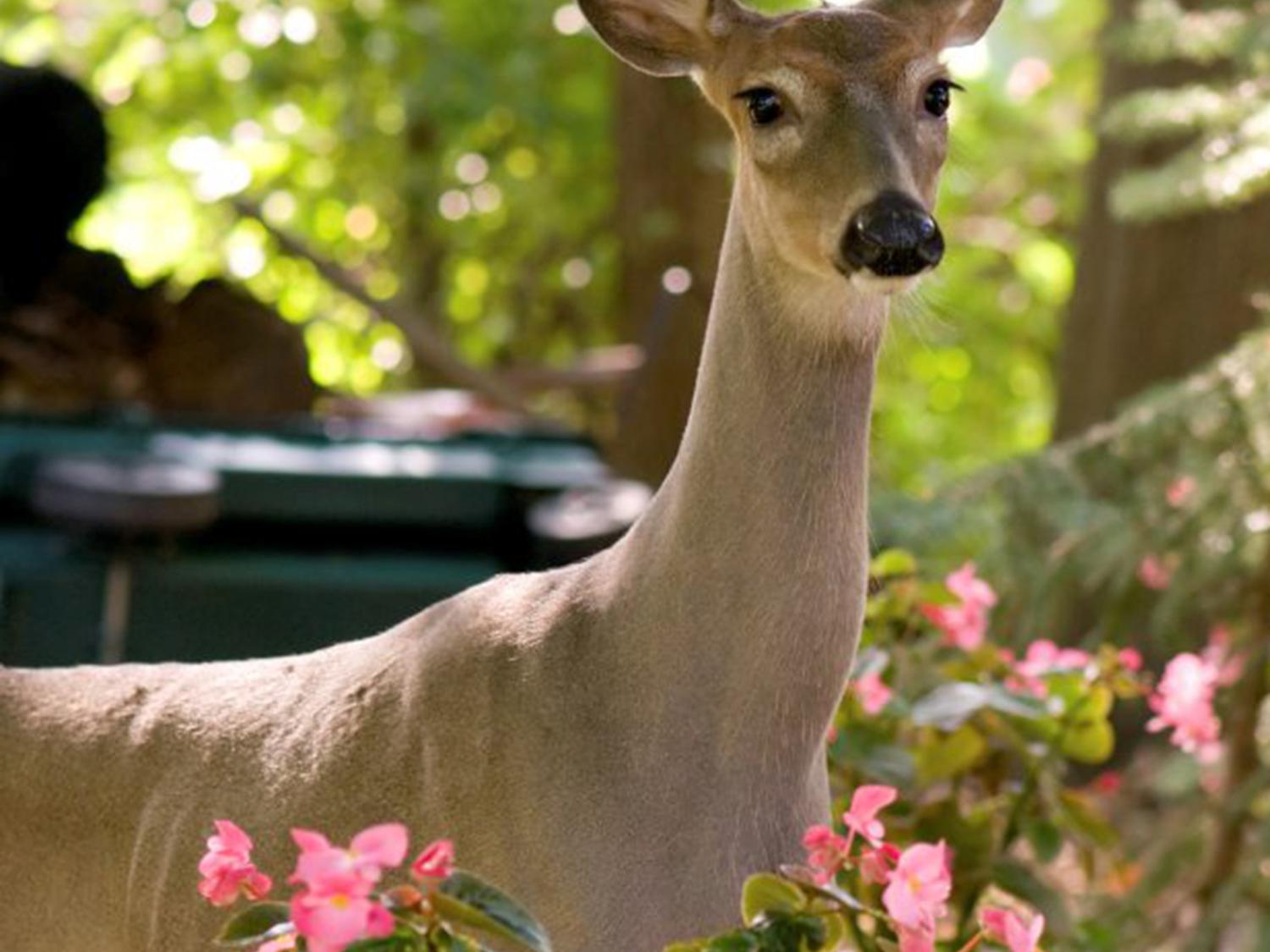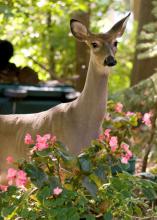Information Possibly Outdated
The information presented on this page was originally released on July 2, 2015. It may not be outdated, but please search our site for more current information. If you plan to quote or reference this information in a publication, please check with the Extension specialist or author before proceeding.
Not my roses! Keep deer out of the garden
STARKVILLE, Miss. -- Summer in Mississippi brings a bountiful buffet of fruits, vegetables, flowers and shrubs to enjoy -- but not just for people. White-tailed deer, avid plant browsers always eager for high-energy food, seem to enjoy the fruits of the gardener’s labor just as much!
Deer can be among the most destructive wildlife intruders for vegetable gardens, flower beds, trees, shrubs, berries and vines. In fact, a small herd of deer can eat and trample a small, backyard garden virtually overnight, according to the Internet Center for Wildlife Damage Management.
Although deer pose an even bigger economic threat to agricultural producers, homeowners can spend thousands of dollars on landscaping only to have it destroyed by the browsing animals. Many homeowners then spend thousands more trying to keep deer out of their gardens.
The Mississippi Department of Wildlife, Fisheries and Parks estimates Mississippi is home to nearly 2 million deer. Although the state remains fairly rural, deer seek refuge in areas that offer shelter, plentiful food, few predators and abundant water sources. Suburban areas offer enough cover to keep the animals hidden, while also providing nutritious food sources without the deer having to expend much energy.
Typically, deer don’t make a “choice” to live in suburban areas. Road and building development, along with deforestation for homes and agriculture, have led to what we call “habitat fragmentation.” This term means that patches of suitable deer habitat are interspersed between residential and highway areas. Often, human activity can inadvertently push wildlife populations into smaller habitats, which don’t provide enough food. Wildlife must seek other food sources elsewhere, namely in people’s yards.
Many homeowners who report deer damage to gardens and landscapes also report enjoyment in seeing these creatures. These homeowners often want to provide some food source for the deer, such as corn or a mineral lick. It is important to note that inviting deer into your backyard could also mean bringing deer ticks that carry Lyme disease onto your property in addition to sacrificing your roses or other landscape plants.
While seeing deer bound through your yard on occasion is exciting and enjoyable, wildlife professionals recommend that homeowners try to minimize deer visits by not offering alternative food sources. The first step in preventing deer damage is to make your property less attractive to these animals. This goal entails a combination of tactics, such as repellents, scare devices, deer-resistant landscaping and possibly even electric fencing.
If possible, before implementing any preventive measures, contact a local horticulturist who can help you determine what types of deer-resistant plant species grow well in your area. Netting, high fences, plant boxes, tree mesh and other physical exclusion devices can be expensive but will most likely provide the best plant protection against deer browsing.
Manufacturing deer repellants has become a multimillion-dollar industry over the past 10 years. Predator-odor-based repellents such as coyote, bobcat or cougar urine have been very popular. Using these chemicals, however, could invite other wildlife species onto your property.
Commercial repellants, such as sprays that coat plants in a bitter tasting and smelling chemical, make garden and landscape plants unpalatable to deer. These repellents are somewhat effective, but spraying them on vegetables can also make those plants inedible for humans. Always weigh the pros and cons of each option before deciding which one is best for your property, especially where human and pet safety are concerned.
Some “home-grown” remedies also have been advertised as effective among gardening forums and natural or organic gardeners. Some simple scare devices, such as tin plates, strobe lights and even sprinklers have been shown to provide temporary relief against deer browsing.
Reducing deer damage on property is a process. A great place to start is with information on deer densities and behavior in your area. If you and your neighbors see a few transient deer several times per year, investing in a high electric fence may not be necessary. However, if several small herds have taken permanent residence in your neighborhood, you and your neighbors may need to take more extensive steps.
Consult with a local wildlife professional about the problem and get city officials involved. The placement of wildlife or trail cameras may be needed to fully assess the population of deer in the area. Selective harvesting may be necessary in an area that has exceeded its biological carrying capacity for deer. This means deer have no choice but to seek food sources necessary for survival, and their health may be suffering.
In this scenario, deer exclusion tactics will be futile because deer will be forced to eat unpalatable plants and may damage fencing or structures in order to gain access to food. Having too many deer in an area also increases the likelihood of disease spread, deer-vehicle collisions and intolerance toward the animals.

Editor’s Note: Extension Outdoors is a column authored by several different experts in the Mississippi State University Extension Service.









